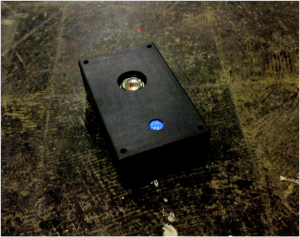In the 90s, art based on new technologies began to enter the public space. One aspect of this was that the use of computer systems enabled interactivity – a dynamic reaction to an input whereby the spectator could take the role of a contributor. This notion of technology as an enabler of social interaction came right at a time when there was an enlivened public debate about the role of art in public space and its social potential.

Brickets - a solar powered simulation of frogs and crickets. It responds to household water consumption, i.e. the frogs sing if you use less than a certain amount of water per day. A light sensor detects when dusk falls.
New technologies also made it possible to connect physical public space and virtual public space (the Internet), thereby making urban public space accessible to a global public, creating a multiplicity of audiences.
The agglomeration of shopping malls and apartment blocks, as well as other high-density inner city housing, has led to a decline in public space. Large property developers have begun to create developments narrowly focused on creating places which generate maximum financial returns. This results in the creation of sterile, similar-looking and controlled spaces. New technologies, either through mobile or permanent installations, offer a transformation of such otherwise closed or unattainable spaces.
Art in public reaches a different audience to that in the museum or gallery – its spectators are somehow more unprepared, yet more open. This kind of art competes with its surrounding environment but also tries to alter it, to add to it, to change the use of that space and perceptions of it. As an electronic artist, I believe that artistic applications of new technologies can play a central role in the public art space, having the potential to alter and augment architecture in a way never seen before.
Combined with real-time environmental data sources, previously abstract concepts such as water and power usage can be visualised using new technologies for the benefit of urban inhabitants. A single building enhanced through a public artwork has the potential to become a landmark – literally a beacon to broadcast a message otherwise easily forgotten or ignored. However, people need to be informed and engaged with the building for any real impact to be made. New technologies offer the potential to generate such impact, both as a catalyst for immersion and spectacle, and as a communication interface between developments in sustainability and the public.
In the current era of global warming, artists face the challenge of tackling these largely social issues in a way that is instrumental yet maintains artistic integrity. The creative interpretation of data relating to sustainable practices is one way to participate in this dialogue. However, artistic representations are sometimes fraught with pitfalls, including the authenticity of data sources, relevance of the interpretation, and the constant threat of ‘window dressing’ – that is, using the conceptual weight of sustainability to mask an otherwise shallow or superficial idea. In response to these anxieties I wrote a short manifesto. It attempts to tackle the complexities of data inspired art and is intentionally provocative and nebulous at the same time.
Data Art Manifesto
Data is amorphous
In order to create effective Data Art, the input must have a non-linear relation to the output.
Data about grass, trees and flowers will never be more important than grass, trees and flowers.
Dirt gets under your fingernails, Data does not.
Data Art is particularly effective when it makes us realise the world is much more expansive than we thought.
Data Art is not about looking at Data. It is about seeing through it.
Art for Data’s sake is not the same as Data for Art’s sake.
There is no such thing as misleading Data Art; there is only boring Data Art
There is no such thing as absolute Data. Data is contextual.
Pierre Proske
Pierre Proske is an Australian electronic artist intrigued by the pervasiveness of technology in culture and its relationship to nature. His background in arts, engineering, philosophy, music and literature has provided him with sufficient options to stay perpetually occupied in a self-inspired quest to weave together several unrelated threads of activity. The result — art, confusion and a slow but steady output of digital chicanery. As an electronic artist Proske turns to open source technologies for practical, aesthetic and ethical reasons. His work involves exposing the unspoken relationships we have with technology, and harnessing machines into exploring new aesthetics. He has exhibited or performed in Australia, Sweden, Brazil, Japan, Peru, Czech Republic and the Netherlands.
 This work is licensed under a Creative Commons Attribution-NonCommercial-ShareAlike 3.0 Australia.
This work is licensed under a Creative Commons Attribution-NonCommercial-ShareAlike 3.0 Australia.






